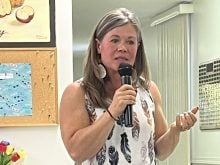Liner repairs to the Lethbridge Northern Irrigation District’s canal system continue, but shortage becoming desperate
The situation for those using water supplied by the Lethbridge Northern Irrigation District in southern Alberta is becoming desperate.
The latest information from LNID does not bode well for irrigation farmers, as emergency repairs continue on a liner that feeds the canal system. It runs from west of Fort Macleod to east of Picture Butte.
“The board never imagined that we would be in the situation that we are faced with today,” read an LNID update.
Related story: Alberta irrigation springs a leak
Read Also

Why feds imposed EV tariffs
Moe and Kinew have a fight on their hands when it comes to eliminating the EV tariff. Canada has to worry about pissing off the U.S. and Mexico and hundreds of thousands of auto workers.
“After a couple years of dealing with low canal flows due to a liner that had reached the end of its life, we were excited that the reline project was underway and would be completed before the 2023 water season. We were devastated to find out about the mess that was created that we as a district are dealing with today.”
The situation is the second water access issue the district has faced in as many years.
Last year, a dispute arose between the provincial government and the Piikani First Nation, which delayed the start of irrigation season.
The province owns and operates the headworks to the LNID canal system located on Piikani Nation land.
The causes of the conflict and the resolution were never made clear.
This year, that same stretch of canal fed by the Oldman River was found to have major leaks in early May.
Some water is getting through with water allocations going from one inch per irrigation acre in early May to 4.5 as of June 15.
But it’s a far cry from the more than 10 inches usually provided.
As in 2022, many questions remain.
Compounding the issue is the lack of information about how much water will be available this year, said Barons, Alta., farmer Dave Bishop.
“Originally, it was an inch and a half for the year, then it was two and a half. They’ve slowly been increasing it. But we still don’t know what our total allotment is going be for the year, so it’s pretty hard to plan. I’ve already cancelled all my liquid fertilizer because we usually put fertilizer down with the irrigation.”
While Bishop said he’ll have issues with his oilseeds, pulses and cereals, specialty crops face the biggest challenge because rain has failed to make up for the water shortfall.
“I’m not going to be affected as badly as people with specialty crops; you know, the ones that need the full allotment of water like potatoes, corn. They’re the ones that are really going to be hurt,” said Bishop.
This year has been particularly bad because it follows two years of dry conditions, but he said the irrigation issues are especially frustrating because it was intended to deal with conditions like this.
“I can’t control the weather, but they should be able to control us getting water. We paid for this water, we’ve put the infrastructure in for irrigation and we’ve paid for this water and it’s really frustrating to see that they can’t seem to fix a leak,” he said.
“These leaks have been around for I think about three years now so it’s not (that) it didn’t just happen. So, they’ve been going to fix it, going to fix it and they went to fix it and they made it worse.”
In a statement from Alberta Agriculture, the ministry said it’s invested in getting the system running again.
“The contractor is working very hard to complete the required repairs as soon as possible and we are taking the necessary steps to avoid water interruptions for this and future growing seasons,” read the statement.
The ministry did not provide details regarding the situation or why it occurred.
Other irrigation districts are faring better, but haven’t been immune to the dry conditions and low mountain runoff.
The St. Mary River Irrigation District notified users of a modest reduction of its water allocation from 15 inches to 14 per irrigated acre.
The Eastern Irrigation District (EID) has also issued a notice for irrigators to reduce water use to 12 inches because of low water levels in the Bow River.
The usual May and June rains, which hit the upper Bow Basin, haven’t materialized, said Ivan Friesen, EID general manager.
The Bow River Irrigation District has no plans to reduce its allocation from the current 20-inch level. However, it is advising irrigators to be careful with water use because drawing down reservoir levels could affect next year’s water allocation.
There is some good news for southern Alberta farmers and irrigators as a mid-June snowfall event has hit the mountains with rain falling in many areas across the region since June 15.
















